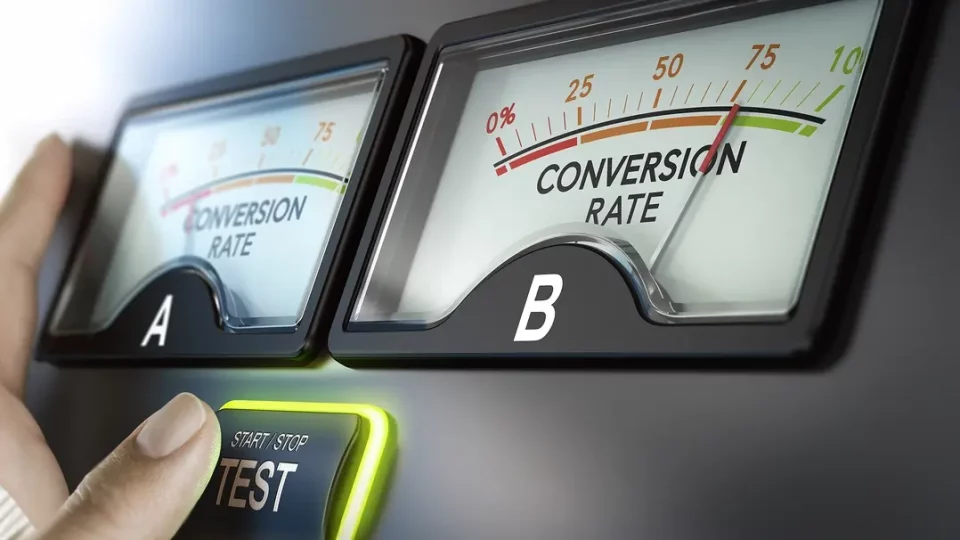
Many websites struggle to turn website visitors into customers. It’s a common problem that requires attention to detail and knowing what to watch for. Transform your site into a conversion magnet with these expert tips on personalization, A/B testing, and mobile optimization. Let’s dive in!
Understanding Website Conversions
When we talk about website conversions, we’re diving into the heart of what makes your online presence successful. Every visitor is a potential customer, each click a pathway, and every main action they take? That’s a conversion – those golden moments where interest transforms into action.
What is conversion rate optimization?
A website conversion is when a visitor completes a specific, desired action on your site. This action could range from signing up for a newsletter or downloading a guide, to making a purchase or booking a consultation. These conversions signal that your site is not just being seen but is resonating and compelling visitors to act.
Conversions are the clearest indicator of your website’s success in fulfilling its ultimate goal: to turn visitors into engaged customers or clients. They are the bridge between passive browsing and active engagement, helping you measure the effectiveness of your content, offerings, and user experience.
High conversion rates indicate your audience is not just watching, but they’re loving what they see.
Key Metrics to Track
In our previous exploration, we delved into the essentials of website KPIs, which you can read at Mastering Website KPIs. Now, let’s deepen our understanding and refine your website conversion capabilities by spotlighting specific metrics that illuminate user behavior and your site’s overall effectiveness.
Here are some of the metrics you’ll want to keep an eye on:
- Conversion Rate. This is the big one – the percentage of visitors who complete a desired action out of the total number of visitors. A high website conversion rate is a clear sign that your are effective at convincing visitors to take the plunge and engage with your content or offerings.
- Bounce Rate. It’s important to know how many visitors leave your site after viewing just one page. A high bounce rate might indicate that your landing pages aren’t in line with the visitor’s expectations.
- Traffic Sources. Understanding where your visitors are coming from (search engines, social media, direct visits, or referral sites) can help you tailor your content and website conversion strategies to suit their preferences and the context of their visit.
- Exit Pages. Identifying which pages your visitors are on when they decide to leave can offer insights into where your site might be falling short in keeping their interest or guiding them toward a website conversion.
- Average Session Duration. The longer visitors stay on your site, the more engaged they are, and the higher the chances of conversion. This metric helps you gauge the overall engagement level of your site’s content.
- New vs. Returning Visitors. Tracking how many new versus returning visitors your site receives can help you understand if your site is good at attracting repeat interest and maintaining a loyal audience, which means they are more likely to convert.
By keeping a close eye on these metrics, you’ll gain invaluable insights into how well your site resonates with visitors and where you can fine-tune your strategies to boost those all-important conversion rates. Remember, each website conversion is a testament to your ability to engage and persuade.
The Role of SEO in Boosting Website Conversions
Search Engine Optimization (SEO) isn’t just about getting more eyes on your page; it’s about getting the right eyes. Effective SEO ensures that your website is visible to a targeted audience actively seeking what you offer, thereby increasing the likelihood of conversions. Implementing smart, strategic SEO practices can significantly enhance your site’s user experience and search engine ranking, leading to higher conversion rates. For more insights on SEO strategies, check out our Marketing Manager Insights article.
Importance of SEO for Visibility
No matter how great your offerings are, if people can’t find you, there’s no deal. That’s where SEO comes into play. It guides potential customers to your website.
SEO boosts your visibility in search engine results, ensuring that when someone is looking for what you offer, your site pops up. This increased visibility means more traffic, and more traffic means a greater number of opportunities to convert visitors into leads or sales.
SEO Practices That Enhance Website Conversions
To turn that increased visibility into tangible conversions, you need to apply SEO practices that not only attract visitors but also encourage them to take the desired action. Here are some key SEO tactics that can help enhance your conversion rates:
- Keyword Optimization. Incorporating the right keywords involves speaking your customers’ language. It ensures that your content aligns with the search queries of your target audience, drawing in visitors with high intent to purchase or engage. Use keywords that match the user’s search intent and sprinkle them naturally throughout your high-quality, informative content.
- Meta Tags and Descriptions. These are your first interaction with your potential customers. Craft compelling meta titles and descriptions that not only include relevant keywords but also entice the user to click through to your site.
- High-Quality Content. Content is king in the SEO world. Providing valuable, engaging, and informative content positions your site as an authoritative source, encouraging visitors to stay longer, engage more deeply, and ultimately, convert. Regularly updated content also signals to search engines that your site is relevant, thereby boosting rankings and visibility.
- Mobile Optimization. With the increasing prevalence of smartphones, your site must perform flawlessly on mobile devices. Mobile-friendly sites rank higher in search results and provide a better user experience, significantly impacting your website conversion rates.
- User Experience (UX). A site that’s easy to navigate and pleasing to use can make a massive difference in conversion rates. Improving site speed, simplifying navigation, and ensuring your website is accessible can lead to more engagement and conversions.
- Trust Signals. Incorporate elements that build trust, such as SSL certificates, privacy policies, and clear contact information. Websites that appear more trustworthy tend to rank higher and inspire visitors to convert.
By integrating these SEO practices, you’re not just aiming to increase your site’s visibility; you’re enhancing the user’s journey from the moment they click on your link to the moment they decide to convert.
Leveraging PPC for Immediate Results
While SEO is a long-term strategy, Pay-Per-Click (PPC) advertising such as Google Ads and Social Media Ads offer immediate boosts. PPC can catapult your site to the top of search results, providing instant visibility and quick website conversions. However, the magic lies in crafting ads that are not only clickable but also compelling enough to convert visitors into customers.
Benefits of PPC in Conversion Strategy
- Quick Spotlight. Jump straight to the top of search results, grabbing attention right when it counts.
- Precision Targeting. Tailor your ads to echo the desires of your audience, making every click a step closer to a website conversion.
- Clear Results. Track every dollar spent, knowing exactly how your campaign is performing and where your budget is going.
- Adaptable. Change your ads on the fly, keeping up with trends and audience preferences to stay relevant and impactful.
Tips for Effective PPC Campaigns
- Set Clear Goals. Know what you’re aiming for, whether it’s boosting sales or getting more leads. Your goals are your roadmap.
- Choose the Right Keywords. Go for keywords that signal a strong readiness to engage or buy, connecting you with users who are ready to act.
- Engaging Ad Copy. Write compelling, clear, and concise ads that resonate with your audience and encourage clicks.
- Optimize Landing Pages. Make sure your landing pages deliver what your ads promise, ensuring a seamless journey from click to website conversion.
- Experiment and Adjust. Continuously test and tweak your campaigns based on real-world performance data to keep refining your success recipe.
The Impact of Link Building on Domain Authority
Link building is the secret sauce of SEO. Quality backlinks from reputable sites signal to search engines that your site is also credible, which can improve your rankings. More importantly, a higher domain authority enhances user trust, significantly contributing to higher website conversion rates.
Link Building and Its Effect on SEO
Link building is the art of acquiring hyperlinks from other websites to your own. These links serve as endorsements, signalling to search engines that others vouch for your content.
The magic of link building shines brightest in its impact on SEO. Search engines view these links as indicators of your website’s quality and relevance. A robust portfolio of high-quality backlinks significantly boosts domain authority, which is a crucial metric influencing your site’s ability to rank higher in search engine results. Higher domain authority means better visibility, more organic traffic, and enhanced trustworthiness, all of which are essential ingredients in the recipe for online success. Explore our Link Outreach and Link Insertions services to enhance your SEO strategy.
Strategies for Quality Link Building
The link building pursuit requires a blend of creativity, persistence, and strategic thinking. Here are some strategies to help:
- Create Stellar Content. Content is the gravitational pull that attracts links naturally. Craft informative, engaging, and valuable content that others find useful or interesting enough to link to. Whether it’s insightful blog posts, infographics, or compelling videos, exceptional content can earn you links organically.
- Guest Blogging. Share your expertise and knowledge on reputable sites in your niche through guest blogging. It’s a win-win: you provide valuable content for their audience, and in return, you get a quality backlink to your site.
- Build Relationships. Engage with your online community, connect with influencers, and participate in industry forums. Building strong relationships can lead to organic link-building opportunities, as people are more likely to link to content from sources they know and trust.
- Use Resource Links. Reach out to websites that maintain a list of resources or directories relevant to your niche. If you have content that adds value to their audience, they might be inclined to include a link to your site.
- Broken Link Building. Identify broken links on other websites that relate to your content. Contact the site owner to report the broken link and suggest replacing it with a link to relevant content on your site. It’s helpful for them and beneficial for you.
- Monitor Your Backlinks. Keep an eye on your link profile to ensure the quality of your backlinks. Use tools to monitor your backlinks, identifying any that might be harmful or of low quality and take steps to address them.
By weaving these strategies into your SEO plan, you can build a network of high-quality links that not only boost your domain authority but also enhance your visibility, credibility, and reach. Link building is a continuous effort that, when done effectively, can illuminate your website’s presence and authority.
Content Creation: The Heart of Engagement
Content is the currency of the web. Engaging, valuable, and relevant content attracts visitors, keeps them on your site, and encourages conversions. Whether it’s informative blog posts, compelling case studies, or engaging videos, quality content can dramatically impact your website conversion rates. Let’s cover how the right content can lead to more clicks and the kinds of content that really get people excited.
How Content Drives Website Conversions
Good content is all about creating that “Wow, this is exactly what I was looking for!” feeling. When content hits the mark, visitors are more likely to trust you and take action.
Types of Content That Perform Best for Conversions
Some types of content are magnets for website conversions:
- Blog Posts. These are great for sharing useful info, tips, or stories that make readers want to engage more with your site.
- Videos. A quick video can say a lot, showing off your products or just making visitors feel more connected to your brand.
- Infographics. Perfect for visual learners, infographics present facts or data in a way that’s easy to digest and hard to resist.
- Customer Stories. Sharing real-life experiences of happy customers can convince others that they’ll be happy too.
- Guides and Ebooks. These offer in-depth looks at topics your audience cares about, showing them you’re an expert they can trust.
- Interactive Content. Things like quizzes or tools that get visitors involved can be super engaging and fun, making them more likely to stick around.
Optimizing User Experience (UX) for Higher Conversions
A seamless user experience keeps potential customers from bouncing off your site. An intuitive, easily navigable, and fast-loading website encourages visitors to stay longer, increasing the chances of conversion.
Importance of UX in Retaining Visitors
- Great First Impressions. Your website needs to strike the right chord immediately. A smooth UX makes visitors want to stick around and explore.
- Builds Trust. When your site is easy to use, people feel taken care of. They’re more likely to trust your site and take action, like buying something or signing up for your newsletter.
- Boosts Engagement. An enjoyable visit encourages visitors to interact more with your site, whether it’s clicking, reading, or buying.
Best Practices for an Optimized UX
Here are some quick tips to make sure your site is as visitor-friendly as possible:
- Keep It Simple. A clean, clear website helps visitors find what they want without any hassle.
- Stay Consistent. Use the same styles and layouts throughout your site so visitors feel comfortable and know what to expect.
- Make It Responsive. Your site should look good and work well on any device.
- Speed It Up. A fast site keeps visitors happy. No one likes waiting for slow pages to load.
- Clear Directions. Use straightforward calls to action, like “Buy Now” or “Sign Up,” so visitors know what to do next.
- Everyone’s Welcome. Make sure your site is easy for everyone to use, including people with disabilities.
CRO Techniques For Your Website
Website Conversion Rate Optimization is about turning visitors into customers. Through various techniques such as improved calls-to-action, simplifying forms, and enhancing landing pages, you can increase the percentage of visitors who convert.
CRO involves fine-tuning your website to make sure more visitors do what you hope they will, whether that’s buying a product, signing up for a newsletter, or filling out a form. It’s about knowing what your visitors like and removing roadblocks.
Effective CRO Strategies
Here are some straightforward tweaks to help turn more visitors into active customers:
- User Testing. Watch how real people use your site to find any spots where they get stuck or confused.
- A/B Testing. Try out two versions of a page to see which one works better, changing things like titles, buttons, or images.
- Clear Calls-to-Action. Make sure it’s super clear what you want your visitors to do, with standout buttons and simple instructions.
- Streamline the Process. Check that the path to making a purchase or signing up is as quick and easy as possible… and don’t forget those thank you pages!
- Mobile-Friendly. Lots of people browse on their phones, so ensure your site is easy to use on a small screen.
- Urgency and Scarcity. Sometimes, showing that an offer is about to end or that there’s only a few left can encourage people to act fast.
- Personalize. Make your visitors feel special with content or offers tailored to their interests or location.
- Keep Testing. Always be on the lookout for ways to improve and make sure to keep an eye on how changes affect your visitor’s actions.
A/B Testing: Finding What Works Best
A/B testing is a fantastic way to optimize for website conversions. By testing different versions of your web pages, you can discover which elements resonate most with your audience and refine your website for maximum effectiveness.
Why A/B Testing Rocks for Boosting Conversions
A/B testing is key because it shows you exactly what works best on your website. Instead of guessing what might make people click or buy more, you can use real results to make smart changes. It’s all about finding out what your visitors prefer and then giving them more of that, which usually leads to better results, like more sign-ups or sales.
Tips for Effective A/B Testing
Here’s how to nail your A/B testing:
- Know Your Goal. Decide what you want to improve, like getting more people to sign up for your newsletter.
- Change One Thing at a Time. Only test one difference at a time so you know exactly what’s making an impact.
- Make Two Versions. Create a second version of your page with just that one change.
- Split Your Visitors. Show half your visitors the original page and the other half the new version.
- Give It Time. Let the test run long enough to get clear results, usually a few weeks.
- Check the Data. See which version did better and use that one on your site.
Utilizing Social Proof to Build Trust
Social proof is about showing that other people trust and like your product or service, which helps new visitors feel good about choosing you. Let’s quickly dive into why social proof is super important and how you can show it off on your website.
Here’s how you can sprinkle some social proof magic on your site:
- Customer Testimonials. Share happy comments from customers to show newcomers they’re in good hands.
- Reviews and Ratings. Let visitors see what others think with user reviews or stars, helping them decide with confidence.
- Case Studies. Tell success stories of how your product or service helped others, showing the real value you provide.
- Social Media Love. Show how many likes or shares you’ve got, proving that lots of people think you’re awesome.
- Trust Badges. Display any awards or seals that show you’re recognized and trusted in your field.
- Famous Fans. If an influencer likes your stuff, show it off! It’s a big thumbs-up for what you’re selling.
Mobile Optimization: Catering to the Mobile Audience
With the increasing prevalence of smartphones, your website must perform flawlessly on mobile devices. Mobile optimization ensures that visitors have a positive experience on your site, regardless of the device they’re using, which can significantly boost website conversions.
Everyone’s on their phones these days. If your site isn’t easy to use on a smartphone, people will just move on. Mobile optimization means making sure your website is ready and friendly for all those mobile visitors, so they have a great experience and stick around.
Here’s how to make sure your website is a mobile-friendly star:
- Responsive Design. Your site should look good on any device, automatically adjusting to fit the screen, whether it’s a phone or a tablet.
- Quick to Load. Mobile users are in a hurry. If your site is slow, they’ll bounce, so keep it speedy.
- Easy Navigation. Big, easy-to-tap buttons and simple menus help people find what they need without any fuss.
- Clear Text. Use text that’s easy to read on a small screen, so visitors don’t have to zoom or squint.
- Simple Forms. If your site has forms, make them easy to fill out on a phone, with minimal typing needed.
- Clickable Contact Info. Make sure your phone number is a clickable link.
Analyzing and Acting on Data
Data is your roadmap to conversion optimization. Regularly analyzing your website’s performance data helps you understand what’s working and what’s not, enabling you to make informed decisions that can lead to higher conversion rates.
Data analysis is key because it:
- Shows you what’s working (or not) on your website.
- Helps you spot trends, like what visitors prefer or avoid.
- Guides you to personalize the experience for different types of visitors, making them more likely to take the action you want.
Tools and Methods for Effective Data Analysis
To turn your data into actionable insights, consider using the following tools and methods for effective data analysis:
- Analytics Platforms. Setting up tools like Google Analytics 4 give you a full view of how your site is doing and what your visitors are up to.
- Heatmaps. Behavioral data show you where people are clicking and looking on your site, helping you place important content or buttons in the right spots. Some of the better known options include Hotjar and CrazyEgg.
- Conversion Funnels. They help you see where visitors stop engaging, so you can fix any issues and make their journey smoother. CRM commonly include conversion funnels, but if you’re looking for something more straightforward both Pipedrive and Heap are solid options.
- A/B Testing Tools. Compare different versions of your pages to find out which one performs better in terms of encouraging visitors to take action. Hotjar and CrazyEgg both have good A/B testing features.
- Customer Feedback. Direct insights from surveys or feedback forms can tell you a lot about what your visitors think and want.
- Segmentation. Breaking down your data can show you how specific groups of visitors behave, allowing you to tailor your site to their preferences.
By using these tools and approaches, you can sift through your data to find nuggets of insight that will help you tweak your website performance, leading to better experiences for your visitors and more conversions for you.
Personalization and Its Impact on Conversions
Personalization is about making every visitor feel special by showing them things they’re interested in, just like that coffee shop where the barista knows your order by heart. This makes people more likely to buy from you because they feel understood and valued. By tweaking your website to fit each visitor’s tastes — from the products they see to the messages they receive — you create a friendlier space that encourages them to take action, whether it’s buying something or signing up for updates.
Start by collecting bits of information about your visitors, like what they look at on your site or where they’re from. Use this info to show them stuff they’ll love, like suggesting products similar to those they’ve checked out before, or even sending them a happy birthday message with a special offer. It’s all about using what you know to make their experience feel tailored exclusively for them.
Wrapping Up
Enhancing your website’s conversion rates is a continuous process of improvement, experimentation, and fine-tuning. With Authority Pilot’s proficiency in SEO, PPC, link building, and crafting compelling content, you’re doing much more than just boosting conversions—you’re laying the groundwork for enduring online achievement. Embrace these tactics, delve into the possibilities, and witness your website evolve into a conversion powerhouse to not only meets but exceeds your business goals.







